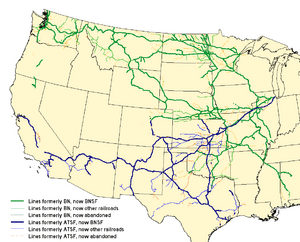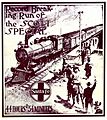Atchison, Topeka and Santa Fe Railway facts for kids
 |
|

ATSF system (shown in blue) at the time
of the BNSF merger |
|
| Overview | |
|---|---|
| Headquarters | Chicago, Illinois |
| Locale | |
| Dates of operation | 1859–1996 |
| Successor | Burlington Northern and Santa Fe Railway (later BNSF Railway) |
The Atchison, Topeka and Santa Fe Railway (reporting mark ATSF), often called the Santa Fe or AT&SF, was a very large railroad company in the United States. It started in February 1859. The railroad reached the border between Kansas and Colorado in 1873. By 1876, it had arrived in Pueblo, Colorado.
To get more people to use its services, the railroad opened offices to sell farm land. This helped create a need for their trains. Even though it was called "Santa Fe," the main train line never actually went to Santa Fe, New Mexico. This was because the mountains and land were too difficult to build on. Instead, a smaller branch line from Lamy connected to Santa Fe.
The Santa Fe Railway officially stopped operating on December 31, 1996. It joined with the Burlington Northern Railroad to form a new company called the Burlington Northern and Santa Fe Railway.
Contents
The Santa Fe Railway: Building an Empire
The Atchison, Topeka & Santa Fe Railway (AT&SF) was officially created on February 11, 1859. Its main goal was to connect Atchison and Topeka, Kansas, with Santa Fe, New Mexico.
Early Days and Growth
In its first years, the railroad played a big part in helping people settle in Kansas. A lot of the company's money came from carrying wheat grown in Kansas. They also transported cattle that were herded north from Texas to towns like Wichita and Dodge City. By September 1872, the railroad was busy moving these goods.
The AT&SF trains reached Albuquerque in 1880. As mentioned, Santa Fe, the original place the railroad wanted to reach, was served by a short branch line from Lamy, New Mexico.
Joining Forces: The Burlington Northern Merger
On September 22, 1995, the AT&SF railroad joined with the Burlington Northern Railroad. Together, they formed a new company called the Burlington Northern & Santa Fe Railway (BNSF).
The two railroad companies continued to run their operations separately for a while. However, on December 31, 1996, they officially became one company, the BNSF.
Santa Fe Railway by the Numbers
The Atchison, Topeka and Santa Fe Railway grew a lot over the years. Here's a look at some of its numbers from 1870 and 1945:
| 1870 | 1945 | |
| Money earned (Gross operating revenue) | $182,580 | $528,080,530 |
|---|---|---|
| Total track length | 62 miles (100 km) | 13,115 miles (21,107 km) |
| Freight carried | 98,920 tons | 59,565,100 tons |
| Passengers carried | 33,630 | 11,264,000 |
| Locomotives owned | 6 | 1,759 |
| Unpowered rolling stock owned | 141 | 81,974 freight cars 1,436 passenger cars |
- Source: Santa Fe Railroad (1945), Along Your Way, Rand McNally, Chicago, Illinois.
Images for kids
-
AT&SF trademark in the late 19th century incorporated the British lion out of respect for the country's financial assistance in building the railroad to California.
-
A comparison map prepared by the Santa Fe Railroad in 1921, showing the "Old Santa Fé Trail" (top) and the AT&SF and its connections (bottom)
-
AT&SF and SP Railroad trains meet at Walong siding on the Tehachapi Loop in the late 1980s.
-
ATSF EMD F7 in classic Warbonnet livery, leading the San Diegan, heading south near Miramar, California, in 1973
-
AT&SF#1129, a 1902 Baldwin 2-6-2 Prairie locomotive, preserved at Las Vegas, New Mexico, since 1956
-
AT&SF No. 870, a 1906-built 2-8-0 from Burnham, Williams & Co. on static display at park in Santa Fe Springs
-
Santa Fe#103, an EMD FT unit decorated in the "Cat Whiskers" scheme, receives service during World War II.
See also
 In Spanish: Ferrocarril de Atchison, Topeka y Santa Fe para niños
In Spanish: Ferrocarril de Atchison, Topeka y Santa Fe para niños





























